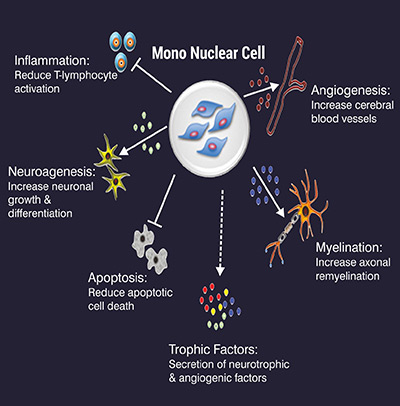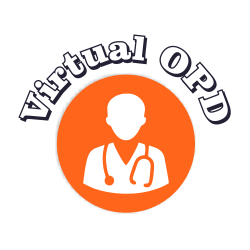A Traumatic Brain Injury (TBI) or Head Injury is caused by an external force. It could cause a severe blow to the brain culminating into serious injury. This injury, can lead to some complications like lack of oxygen to the brain with rising pressure and swelling of the brain tissue. A head injury can be grouped into closed and penetrating brain injury.
A Traumatic Brain Injury (TBI) or Head Injury is caused by an external force. It could cause a severe blow to the brain culminating into serious injury. A head injury can be grouped into closed and penetrating brain injury. A closed head injury happens when the brain and the skull remain intact. On the other hand, a penetrating Head Injury happens when a sharp item breaks opens the skull and enters the brain.

Autologous bone marrow mononuclear cells grafting for traumatic brain injury stimulates neurons as a consequence of neuroplasticity. Through this we not only form new cells but also reinforce the ongoing neuroplasticity. Many types of bone marrow-derived cells can be employed during autologous bone marrow mononuclear cells grafting for traumatic brain injury.
Bone marrow derived bone marrow-derived cells are able to form neural cells. They help restore the damaged brain tissue after a traumatic brain injury. The transmitted bone marrow-derived cells to the brain can build a repair and renewal process of newer blood vessels. Development of new axons, neurogenesis and fresh communication between neurons help renew the brain damage. Some growth and neurotrophic factors help in restoring the neuron protection.
Autologous bone marrow mononuclear cells grafting for traumatic brain injury helps restore lost cells through proliferation and differentiation. This transmits into the nervous tissues like astrocytes, oligodendrocytes and endothelial cells and ascertains practical improvement. To conclude, autologous bone marrow mononuclear cells grafting for traumatic brain injury in India is a successful treatment for Head Injury and facilitates to heal the injured area.
A severe Head Injury / Traumatic Brain Injury (TBI) can be physically, mentally and emotionally shattering. Autologous Bone Marrow Mononuclear Cells Grafting for traumatic brain injury generates new hope in patients. The Autologous Bone Marrow Mononuclear Cells Grafting for traumatic brain injury in India, at NeuroGen, is followed by personalised physical therapy.
STATISTICS OF OVERALL IMPROVEMENTS IN PATIENTS AFTER AUTOLOGOUS BONE MARROW MONONUCLEAR CELLS GRAFTING FOR TRAUMATIC BRAIN INJURY/ HEAD INJURY IN INDIA AT NEUROGEN
94% patients have shown overall improvements
Improved higher mental functions
Better posture
Increased trunk activity
More upper limb activity
Improved lower limb activity
Better coordination
Increased oromotor skills
Improved ambulation
More activities of Daily Living
Our patients exhibit clinical improvements which are co related with the affirmative changes that are seen in damaged nervous tissues as demonstrated by the PET-CT scan of our patients.
The session of Autologous bone marrow mononuclear cells grafting treatment for Traumatic Brain Injury in India together with neurorehabilitation facilitates in restoring the neural network by restoring the cells that are lost and all other cells present in the tissues of the brain. The patients who have experienced an acute Head Injury / Traumatic Brain Injury can restore their old life back through these two successful programs.
When a sudden blow or jolt or trauma causes brain damage, then it is known as Head Injury or Traumatic Brain Injury (TBI). The traumatic effect of Head Injury can occur from mild concussion to severe coma.
The recovery process of a Head Injury / Traumatic Brain Injury can be decided upon the level or degree of injury and damage to the brain. The decision can be taken again after studying which brain parts are injured.
Lasting effects like a long-term neurological sequelae or neuro deficits are most likely. It may vary from severe cases of patients in coma, to paralysis of hands and legs, speech issues, swallowing issues, memory or cognitive issues.
Some patients recover completely while some patients suffer from long term problems. The severity can be reduced by doing proper rehabilitation like physiotherapy, occupational therapy, speech therapy, cognitive therapy and so on. Doing this improves the quality of life and takes the patient a step towards functional independence.
A) A comatose patient will experience complications that any bedridden patient will have
B) If the patient does not undergo a rehabilitation session, then certain deformities or contractures are possible due to disuse of limbs
\C) Myositis ossificans can be classified as calcium and bone deposits in the joints which restricts joint movement and ambulation. So giving deep massages should be avoided.
D) Fits or seizures are experienced by some patients, who have suffered a Head Injury or Traumatic Brain Injury (TBI). It usually starts with an antiepileptic.
Autologous bone marrow mononuclear cells grafting for traumatic brain injury along with rehabilitation works in the recovery of neurological deficits like all other incurable neurological disorders. It can help to improve all other problems which cannot be improved by rehabilitation alone.
The biological task of bone marrow-derived cells is to replenish and renew damaged cells. autologous bone marrow mononuclear cells grafting for traumatic brain injury exploits this role by administering these cells in high concentrations directly in and around the damaged tissue, where they move forward with its self healing and repair.
No, there are no ethical concerns surrounding adult stem cell research and therapy. Ethical concerns are mostly occurs through the use of embryonic cells. Our therapy consists of using cells which are taken out from the patient’s own body and it is free from ethical concerns.
The whole autologous bone marrow mononuclear cells grafting session is safe and till date none of our patients have shown any signs of neurological deterioration. In rare cases, side effects like headache for 3-4 days, neck or back pain, vomiting, mild rash or pain at the area of bone marrow aspirations may arise. Some unexpected medical complications can occur but that is just a possibility.
This may vary from patient to patient. Some patients with traumatic brain injury make a speedy improvement by 3-6 months while in some cases patients take several months or years together to heal. And there are some patients that recover even before their discharge.
This will depend on the condition of the patient. If the patient shows signs of improvement after the first surgery then a second transplantation of cells may be suggested by a team of experts. The second transplantation can transpire anytime between 3-6 months of the first autologous bone marrow mononuclear cells grafting.
We will have to review the entire dose of medication before coming upon a decision. Generally we do allow the patients to continue their other medication. But it is better to consult a doctor beforehand
